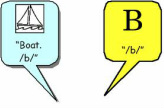What is phonology?

Phonology is the study of the sounds of a language. When
spoken, English can sound like an unbroken string of sounds, but it is actually
made up of many smaller sound units, called phonemes. These small pieces of sound are the “building
blocks of words.” For literacy
development, phonemic awareness is the important process where children learn
to hear and break down words into the individual sounds, blend sounds, and
manipulate sounds to make new words.
For English, Standard American English is often the model for studying and determining the sounds of English, but there are many variations of English which have phonological differences, what native speakers might perceive as different ‘accents’. When considering how English sounds are made, the most significant parts of the mouth are the lips, teeth, tongue, and different parts of the top of the mouth. The following website includes audio and video of the different sounds of English and a few other languages, and provides models of how native speakers make these sounds: Phonetics: The Sounds of English The sounds of English can be organized by consonants and vowels. Consonants depend on the place of articulation (where the sound is made in vocal tract), the manner of articulation (how close the articulators or parts of the mouth get to change airflow to make a sound), and voicing (whether vocal chords produce sound or not). With different combinations of these 3 factors, English speakers produce stop sounds (i.e. /p/, /b/, /d/), fricatives (i.e. /f/, /v/, /h/), affricates (i.e. ch, j), nasals (i.e. /m/, ng), and liquids and glides (i.e. /l/, /r/. Vowels are all voiced (vocal chords producing sound) and rely on the placement of the tongue in the oral cavity, affected by the height, frontness, and tenseness of the tongue. Phonological rules explain what happens when sounds change in different contexts of words, including:
|
In the classroom
Tips for Applying Phonology:
|
